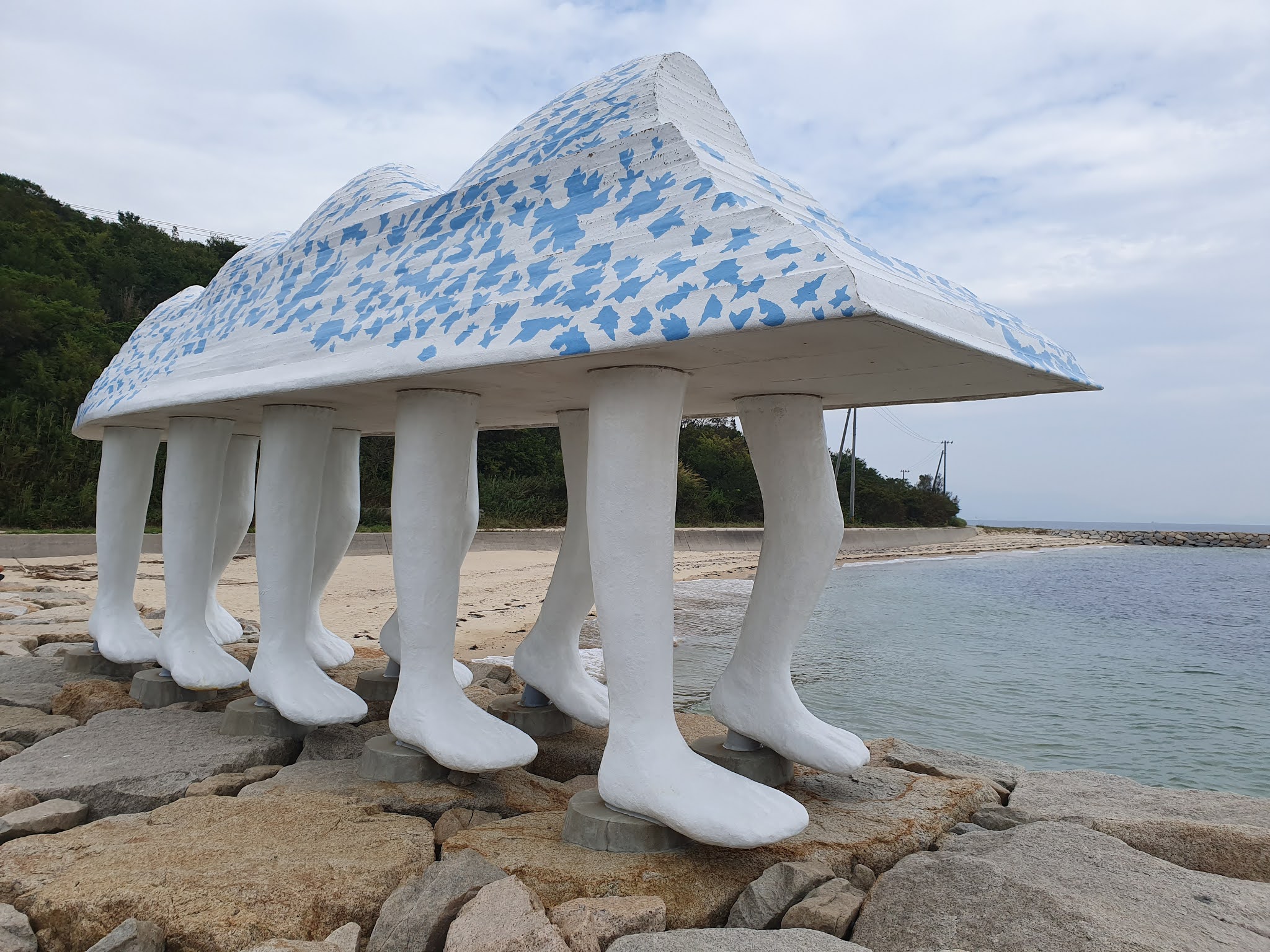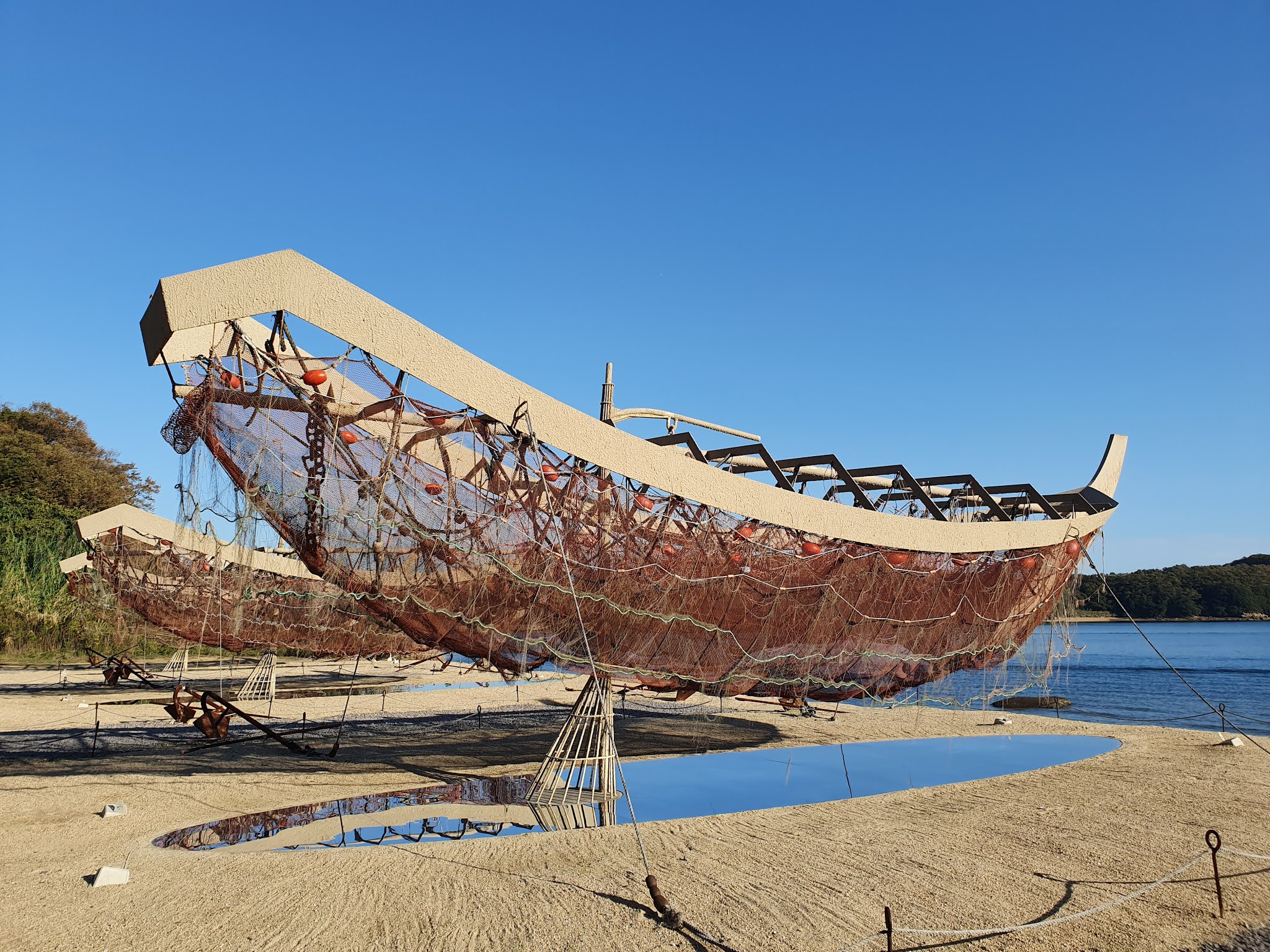Part 5: The Hidden Communities of Japan Art Islands (English)
 Being able to describe different communities through the variety of
experiences that I have is something that gives me lots of joy. In recent blog
posts I mainly focused on Kochi Prefecture, which is where I lived, and my
day-to-day life. In line with the theme of the blog, I want to share different
rural communities and environments in Japan which leads me to Kagawa Prefecture.
One of my favourite Prefectures in Japan, Kagawa Prefecture is located just
north of Kochi. While
known for its delicious udon and beautiful gardens, what brought me here was
the Setouchi Triennale.
Being able to describe different communities through the variety of
experiences that I have is something that gives me lots of joy. In recent blog
posts I mainly focused on Kochi Prefecture, which is where I lived, and my
day-to-day life. In line with the theme of the blog, I want to share different
rural communities and environments in Japan which leads me to Kagawa Prefecture.
One of my favourite Prefectures in Japan, Kagawa Prefecture is located just
north of Kochi. While
known for its delicious udon and beautiful gardens, what brought me here was
the Setouchi Triennale.
One day, I was chatting to a friend of mine who lives in Tokyo, and she
made an off-handed comment about this Art Festival that happens in Kagawa. She
said it is held every three years, and it runs over three seasons (Spring,
Summer and Autumn). I was intrigued, so I did a bit of research and discovered
that it was happening that year. That was all I needed to hear, and I started
planning my trip to the 2019 Setouchi Triennale Summer Session. The Setouchi
Triennale occurs on a series of different islands surrounding Kagawa
Prefecture in the Seto Inland Sea. The aim of the festival is to revitalize
the local area, which has suffered from depopulation in recent years, with the
2019 theme being “Restoration of the Sea”. The festival features over 150
artworks by artists from both Japan and abroad, many of whom make use of
abandoned homes to host or even become their art installations. I am very
excited to share my journey through Setouchi Triennale and unpack the people I
met, the environment I saw, and the experiences along the way. There is so
much I could share, but hopefully this gives you a snapshot.
I recall finishing work on the Friday around 4:45pm and rushing to get the
highway bus for Kagawa which departed at 6:10pm. I arrived in Takamatsu, the
capital city, to check in to the guesthouse that I always stay at. After a
nice catchup with my friend and owner, I went to sleep very excited with the
journey ahead. All installations that I mention will be credited at the
bottom.
I set off at 6am and the first meal I had to have was a
bowl of Sanuki Udon. Sanuki is the former name of Kagawa and is the motherland
of Udon. With some delicious Sanuki Udon in my belly, I jumped on the big red
ferry at 7am to embark on my 1st day journey to the islands of Megijima
(女木島) and Ogijima(男木島) with a population of 200 and 168, respectively.
As the ferry approached Megijima you are instantly struck with enormous
mountain centered in the middle. Megijima is known as Onigashima or Ogres’
Island, and some claim that it was the stage for the Japanese folktale
Momotaro (Peach Boy), a story in which a boy born from a peach vanquishes a
hoard of ogres. The caves where the story is set can be found on the highest
peak, Washigamine (188 meters above sea level). Being so high lends itself to
have a great view of all the different installations on the island. On the
same day, I went to visit Ogijima. Around 20 installations could be seen on
this island during the festival’s summer instalment, all unique and different
in their own way. I gravitated immediately towards a local sourced and delicious
lunch. The owner carefully explained each element of the Teishoku (定食, Set
Meal) with a sense of pride of how each ingredient was sourced.
 |
| The cave at the peak of Washigamine |

A view of Megijima

Teishoku (定食) at Ogijima
 |
| Junko's Library |
The following day and with more delicious udon in my belly, I set my sights on one of the more famous islands in the region, Naoshima (直島町), population 3,117. Riding my bicycle to see all the different exhibits Setouchi had to offer was lovely. Naoshima is known for its permanent collection of art. The most well-known is the Chichu Art Museum (no photos allowed inside). The museum is a set of interlinked, half-buried buildings that house the owner, Soichiro Fukutake’s personal collection of five Monet water lily paintings. Notwithstanding Monet’s art, the most striking work at Chichu for me was James Turrell's (an American) interactive work, where entering the room felt like nothing else existed anymore, and time and space moved and stood still at the same time. The second was by another American, Walter de Maria. This room was a temple-like space with golden pillars mounted on the walls and steps leading up to a giant granite sphere. The most iconic piece on Naoshima is located on the beach: a giant yellow pumpkin by Japanese pop artist Yayoi Kusama, a surreal beacon jutting out into the sea. The pumpkin is a permanent exhibit on the island and is a highly sought-after photo location. Another attraction of Setouchi amongst all the exhibitions on the Island is the funky “i♥湯” public bathhouse, a collage of junkyard scraps and neon signs that operate as a functioning sento. The bathhouse was a nice way to relax after a long day biking around the island (no photos inside, of course!).
Rather than returning
to the Kagawa side, where I was staying, I went Uno Port on the Okayama
Prefecture side of the ocean. There were some more exhibits that I wanted to check out. And there I found Chinu-the Black Sea Bream of Uno which is
created from empty cans, PET bottles, and cast-offs collected from households.
It also can be used as a slide, so of course I wanted to have a go. I had
quite the crowd watching me slide down, filled with Obachans and Ojisans
chatting in the background. They thought I was a Youtuber and gave me a nice
round of applause as I came down. We had a nice chat, and I was on my way back
to Takamatsu, where I went to a local Izakaya and played the original Super
Mario Kart, where I came first in the GP.
The next day, I went to visit Teshima(豊島). In Japanese, the name Teshima means “bountiful island,” and the island is true to its name. Like Naoshima, bikes can be rented at the island’s ports and are a great way to enjoy the beautiful scenery. I hopped on one myself to explore the landscapes of Teshima. First, was the Teshima Art Museum (no photos allowed), which turns the standard idea of what a museum is on its head. For a start, it is empty. Or to be precise, there is nothing on display. Instead of looking at art works or objects, the visitor is invited to contemplate nature in its purest form: light, water, air. The effect is deeply calming. Teshima Art Museum blends in with the surrounding landscape. Curved and low lying, it looks both other-worldly and somehow part of the surrounding landscape. However, the strangest aspect of the museum is its location—next to a rice terrace.
The next day, I went to visit Teshima(豊島). In Japanese, the name Teshima means “bountiful island,” and the island is true to its name. Like Naoshima, bikes can be rented at the island’s ports and are a great way to enjoy the beautiful scenery. I hopped on one myself to explore the landscapes of Teshima. First, was the Teshima Art Museum (no photos allowed), which turns the standard idea of what a museum is on its head. For a start, it is empty. Or to be precise, there is nothing on display. Instead of looking at art works or objects, the visitor is invited to contemplate nature in its purest form: light, water, air. The effect is deeply calming. Teshima Art Museum blends in with the surrounding landscape. Curved and low lying, it looks both other-worldly and somehow part of the surrounding landscape. However, the strangest aspect of the museum is its location—next to a rice terrace.
 |
| Next to Teshima Art Museum |
 |
| Shoji's Strawberry Kakigori (かき氷) |
One
of the more enjoyable exhibitions for me thus far was the interactive
basketball piece, No One Wins—Multibasket by Spanish art duo Jasmina Llobet
& Luis Fernandez Pons. The artwork was a large map of Teshima with a bunch
of basketball hoops on it, and I legitimately could spend hours there, which I
did, because I was waiting for my ferry.
Fast forward 3 months, and I was on my way back from Fukuoka Prefecture. I
caught the night bus where the stars aligned, and I arrived in Marugame City
in Kagawa at 6am. Just in time to catch the ferry to visit an island only
available in the Autumn session of Setouchi Trenaile, Honjima(本島). Since
ancient times, the people whose occupation was “pirate", had been living on
these islands. They became a strong crew with weapons and serious sailing
skills. The crew was called Shiwaku-suigun (塩飽水軍). The locals told me that
Honjima once had a population of around 3,000 in its heyday, however, the
population has dwindled to a mere 450, mostly elderly residents. That being
the case, it is still the most populated island in the Shiwaku Island chain.
Apart from its wonderful history, Honjima also provides one of the best views
of a modern marvel, the Great Seto Bridge, a long suspension bridge spanning
many small islands. I arrived at 6:45am, rented a bicycle, and just rode around
the island in blissful silence, basking in all the beautiful and interesting
pieces that were on display for the Setouchi Triennale.

Sunrise at the Great Seto Bridge

A local Elementary School
As I was riding my bicycle it gave me a chance to reflect on the series of trips that I took. The
Setouchi Triennale transcends the natural beauty present within the islands
and displays a strong feeling of grassroots collectivism by using the
resources around you to help your community. The vast amount of different pieces, exhibitions and artworks I saw was incredible and I felt it played a role in supporting the cause that Setouchi Triennale aims to achieve. With these communities fleeting, it takes the work of strong and passionate individuals to provide “Restoration of the Sea” and give opportunities to future generations to come. I got on the local train from Marugame back to Kochi City where my reliable bicycle was waiting for me at the train station. I rode home back to my apartment and crashed ready to go to work the next day. A transcendent way to end my
journey and an unforgettable experience while visiting the Setouchi Triennale.














Comments
Post a Comment